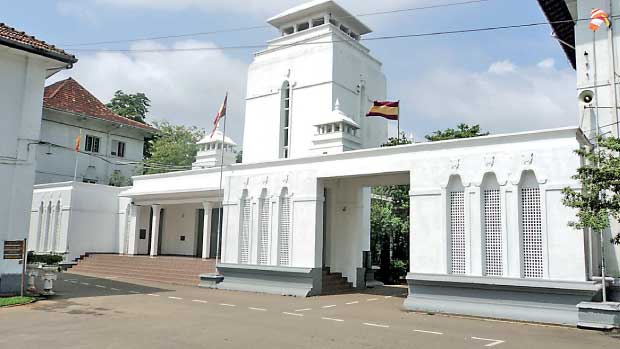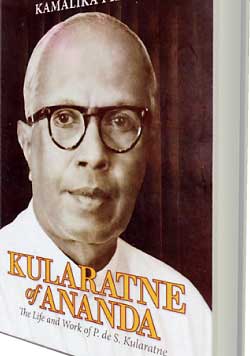Reply To:
Name - Reply Comment
Last Updated : 2024-04-17 02:11:00
Review of Kamalika Pieris’ “Kularatne of Ananda: The Life and Work of P. de S. Kularatne,” published in 2015
 Biographers are like method actors, I have always felt: they try to get into the skins of their subjects. I am no biographer, only a writer, but this truism is valid even for the most pedestrian journalist. You have to have empathy for the person you’re writing on, regardless of your political preferences and of whether they are aligned with those of that other person. It is hard to be completely objective, but if you have managed to depict the many nuances of that individual, you have achieved your goal.
Biographers are like method actors, I have always felt: they try to get into the skins of their subjects. I am no biographer, only a writer, but this truism is valid even for the most pedestrian journalist. You have to have empathy for the person you’re writing on, regardless of your political preferences and of whether they are aligned with those of that other person. It is hard to be completely objective, but if you have managed to depict the many nuances of that individual, you have achieved your goal.
I would like to think that Kamalika Pieris’ biography of P. de S. Kularatne falls into this category of biographies. Like most other national figures from that time, Kularatne was not free of controversy or the vitriol that flows from being controversial. Pieris’ book does not offer us a complete sketch of the man. Indeed, she seems to have written it as an apology for having ignored him and his worth when he was alive. Such an apologia can be cumbersome and tends to adulate on the person being depicted. It is a measure of Pieris’ dexterity that she does not deteriorate that way. Not one bit.
Patrick de Silva Kularatne was born in 1893 in Degoda, Ambalangoda to a Sinhala Buddhist entrepreneurial family. His father was involved in cinnamon, tea and rubber at a village located about seven miles from his hometown. Having educated him at Devananda Vidyalaya in Patabendimulla and later at Dharmasoka College, he sent his son to the leading school in the region back then, Richmond College.
Like every other national figure who emerged from the South, including C.W.W. Kannangara and A.P. de Zoysa, Kularatne was nurtured in the Wesleyan tradition. The fact that he was a Buddhist did not deter him from excelling in various fields, academic and extracurricular, at a predominantly Christian school: by the time he was transferred to Wesley College in Colombo, he would obtain (inter alia) a First Class in the Cambridge Junior Local examination, with distinctions in arithmetic and mathematics. Mathematics was his strongest subject, English literature his weakest.
In March 1913, he left Ceylon for University College in London, where he completed two degrees (Mathematics and Law), was called to the Bar, became a Barrister at Law, and realised that the British Civil Service was not considered as important by Englishmen as it was by his countrymen. After travelling around London and Ireland, he received a cable from W.A. de Silva asking him to become Principal of a leading Buddhist school back home. Thrilled, because he had gone to study in England in order to uplift Buddhist education in his country, he returned.
Kamalika’s book has as much to do with Kularatne as it does with that school, Ananda. He was born about seven years after it was started. When he took over from C.V. Ranawake (he would serve two terms: 1918-1932 and 1936-1943), however, he was not too optimistic about his position: “It did not act as a great inducement to him,” we are told. Nevertheless, by the end of his first term, he had achieved what he had wanted: an elite English education in a Buddhist atmosphere. In six chapters, Kamalika consequently delves into Ananda not just as an educational institution, but as a veritable breeding ground for nationalism.

Kularatne was less a pioneer than an experimenter. We are told that he did not just aim at a revivalist movement in the schools he administered. We are told of the many carnivals he organised and the many extracurricular activities he helped nurture and better their counterparts in Christian schools. We are told of the many academic achievements that school clinched as well. While six chapters seem too much to dwell on a single institution, Kamalika ensures that her prose entrances us. To a considerable extent, this is rooted in her preference for facts over opinion.
That is why we are ready to forgive, forget, and move on even as she inserts frill into her prose. She writes at length not only of Ananda, but of the many other schools Kularatne managed through the Buddhist Theosophical Society, an organisation he distanced himself from as the years progressed. The shift in him from educationist to politician, however, was not as successful, though it was almost as prolific.
Unlike Kannangara, he was critical of the establishment. Unlike A.P. de Zoysa, he was critical of the  Marxists. The schools he administered gave us many of those Marxists – from N.M. to Philip to Bernard Soysa – but it is a testament to Kularatne’s individuality that he disagreed with their materialistic view of history. That individuality proved his undoing, though: in the run-up to the government’s decision to take over both assisted and fee-levying schools, for instance, he backtracked on whether Catholic schools should be taken over. We are told that he had his reasons – he wanted state support for Buddhist schools and to leave the Catholic ones alone – but that did not stop his detractors from calling him a tightrope-walker.
Marxists. The schools he administered gave us many of those Marxists – from N.M. to Philip to Bernard Soysa – but it is a testament to Kularatne’s individuality that he disagreed with their materialistic view of history. That individuality proved his undoing, though: in the run-up to the government’s decision to take over both assisted and fee-levying schools, for instance, he backtracked on whether Catholic schools should be taken over. We are told that he had his reasons – he wanted state support for Buddhist schools and to leave the Catholic ones alone – but that did not stop his detractors from calling him a tightrope-walker.
I have already written of Kamalika’s prose. It remains her biggest strength in her book, so much so that Kularatne of Ananda goes beyond biography and proves to be valuable to both the common reader and the historian. Eschewing commentary for reportage, she makes us aware of her intention in her preface: “I have included every iota of information which I thought would be useful to a researcher later on.”
But Kularatne of Ananda suffers in certain respects. While I don’t doubt the sincerity of her intentions, I feel that Kamalika could or should have delved into the social content of the same Buddhist revivalist movement of which Kularatne was a key figurehead. The debate between theosophy and Buddhism, the emancipation of the Sinhala-speaking bourgeoisie after 1956, and the political rise of the English-speaking, rightwing Buddhist elite who favoured a division between the laity and the clergy, are pertinent for Kamalika’s time, Kularatne’s time, and our time.
Why do I say this? Malinda Seneviratne, known for his outspoken views on nationalism, made the following observation when I asked him about Colonel Olcott’s programme: “I believe that his revivalist programme suffered on two counts. Firstly, it separated ‘Sinhala’ from ‘Buddhist.’ Secondly, it failed to engage with history and heritage.” It is that latter point which interests me, and which I looked for in this book. I couldn’t find it, but while I am disappointed I am aware that the authoress is not beholden to her readers: she has set Kularatne up for dissection and praise, and it is Kularatne who drives her narrative. Everything else is peripheral, I concede.
In the final analysis, Kularatne of Ananda blends in light reading, scholarship, history, and even sociology (though because of its limitations we do not see much of the latter). The fact that it was published two years ago, and has so far failed to generate interest or controversy, reveals where the nationalist project he was part of, in our schools and elsewhere, has taken the common reader to. We should regret, I believe.
At the cost of generating some controversy myself, I will hence end on this note: if Kularatne aimed at delivering English education in a Buddhist country, he did not succeed completely, not because of a lack of sincerity on his part, but because (as Malinda once wrote) more than half a century of swabasha has left us, not an emboldened nation, but a gandabba one, neither here nor there. Perhaps, Kularatne of Ananda has as much to say in what it contains as it has in what it does not contain.

Add comment
Comments will be edited (grammar, spelling and slang) and authorized at the discretion of Daily Mirror online. The website also has the right not to publish selected comments.
Reply To:
Name - Reply Comment
On March 26, a couple arriving from Thailand was arrested with 88 live animal
According to villagers from Naula-Moragolla out of 105 families 80 can afford
Is the situation in Sri Lanka so grim that locals harbour hope that they coul
A recent post on social media revealed that three purple-faced langurs near t

10 Apr 2024
09 Apr 2024